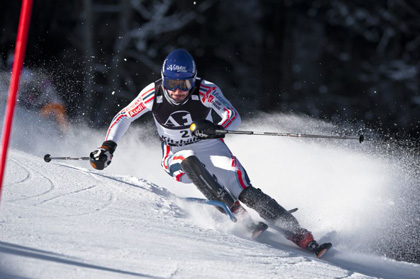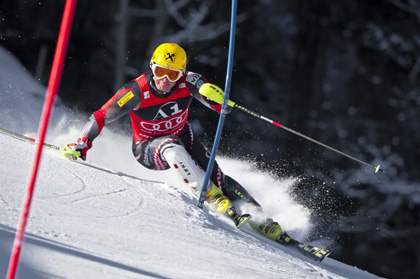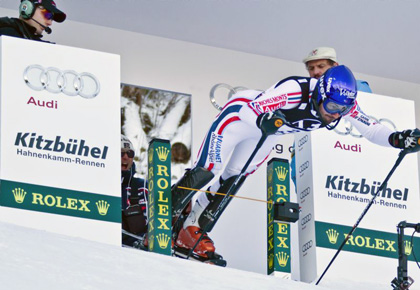
Jean-Baptiste Grange (FRA) winner of the Hahnenkamm Slalom, Photo credit: Rolex / Kurt Arrigo
. world ski news : VICTORIES FOR MINDS AND MEN - 23 ßíóàðè 2011 - 21:20
ALPINE SKI WORLD CUP. The 71st Hahnenkamm Races closed with a stirring second run performance in the Slalom from Frenchman Jean-Baptiste Grange, who edged first run leader Ivica Kostelic of Croatia into second place by 0.28 seconds according to the Rolex Timing.

Jean-Baptiste Grange (FRA) winner of the Hahnenkamm Slalom, Photo credit: Rolex / Kurt Arrigo
Kostelic took his defeat well. His efforts in the Slalom were enough when added to his Downhill time to win him the Combination title, in addition to his Super G crown. A good weekend’s work for the man who explained earlier this week how highly he ranks victory in the overall Alpine Ski World Cup.

Ivica Kostelic (CRO) second overall Slalom, Photo credit: Rolex / Kurt Arrigo
The Austrians who form the bulk of the adoring crowd at the Hahnenkamm have had little home-country success to cheer this weekend. Only Streitberger, third in the Super G, and Romed Baumann, third in the Combination, have approached the lofty hopes of their nation. Yet the unbridled passion of the support and appreciation shown for skiers from all countries, however small in skiing terms, demonstrates why Kitzbühel is Kitzbühel. Nothing rivals it for challenge or atmosphere. The spectators know it; the skiers know it. That is why they return each year.
Off Piste
Downhill skiing is the fastest of the Alpine World Cup disciplines. Skiers regularly reach speeds exceeding 100 km per hour (kph) during their headlong hurtle. This week, the Streif has witnessed the top guns of the descent reaching in excess of 135 kph. Newcomer to the Hahnenkamm Downhill Travis Ganong of the USA almost broke the speed gun yesterday, recording an exceptional137.1 kph at one stage during his first-ever race on the famous course.

Jean-Baptiste Grange (FRA) winner of the Hahnenkamm Slalom, Photo credit: Rolex / Kurt Arrigo
Rolex has had a long association with speed, stretching back to the 1930s. In 1935, Malcolm Campbell wore a Rolex, as he became the first person to drive an automobile at over 300 miles per hour (482 kph). Chuck Yeager wore a Rolex twelve years later, as he became the first person to break the sound barrier, reaching Mach 1 (1,225 kph) in a fixed-wing plane. 50 years later he repeated the exercise, this time in an F-15 fighter.
Next week, Rolex’s continued partnership with the human defiance of inertia moves from the white, mountainous surrounds of Kitzbühel to the flat of Daytona Beach on the Atlantic shore of Florida. Here, in 1959, Rolex cemented its position in motorsport by beginning an association with the Daytona International Speedway. In 1992, Rolex became the title sponsor of the track’s pre-eminent endurance race, the Rolex 24 Hours At Daytona. On 29 January, the 2011 edition gets underway: follow the event at www.caracingnews.com.
Course Notes
Just as its sibling the Streif is considered a downhill classic, so to is the Ganslern in slalom terms. The packed powder covering the terrain today disguised the wide-ranging test the slope poses the skiers. The athletes struggle on the heavily angled incline to find the balanced rhythm necessary to post a good time. Baptiste did it in spades though today, despite supposedly being in recovery from a shoulder injury suffered last year, “I like winning in Kitzbühel, I like the slope; but I was surprised when I crossed the finish line in first. I think this is one of my best victories; it’s always special to win here in the country of skiing, and Kitzbühel is one of the most important races in the season.”
Another podium placer to enjoy the character of the Kitzbühel Slalom was third placed Giuliano Razzoli, who was third last year too, “it’s special. There are lots of people; the course is difficult because of the conditions. Three years ago I did not like the slalom here, but I have trained in the conditions, and now it is beautiful!”
When Kostelic crossed the line and saw he was second, the watching crowd could have been forgiven for thinking he had won the Slalom such was the obvious and emotive nature of his celebration. Kostelic, though, had more things on his mind than just this race, “the Kitzbühel slalom is a very tough race because you are aware you are skiing two parallel races. This makes the Classical Combination so tough. You want to ski fast in the slalom, but you don’t want to ski out…so how do you ski fast? I was so happy in the finish, because for the first time I was able to block thoughts of the Combination and say ‘attack the Slalom’. This was a victory in my head. A special moment to achieve what I wanted in both.”
Hahnenkamm History
Today at the finish of the 71st Hahnenkamm Races, another set of names have been inscribed in the ledger of record, that lists the heroes of Alpine Skiing that have tamed the mountain courses at Kitzbühel.
Didier Cuche of Switzerland took the blue riband Downhill on the Streif for the third time in his career, successfully defending his 2010 title. With the achievement of at least three wins in the full Downhill, Cuche joins an exclusive club with Karl Schranz and Franz Klammer. Klammer, though, still holds the all-time record of four wins.
Ivica Kostelic of Croatia proved he has more in his armoury than just technique, winning the other speed event, the Super G. His formidable performance in the Slalom secured him the Combination title too. The second time he has achieved this at Kitzbühel.
Jean-Baptiste Grange has now twice won the Slalom at the Hahnenkamm Races. His first title came in 2008, part of a run of French success that has seen the Tricolour fly highest on four occasions in the past six events.
Hahnenkamm by the Numbers
The 71st running of this event has seen 146 competitors participate across three disciplines. The athletes represented 26 nations with some less familiar countries lining up along the powerhouses of Austria and Switzerland. Skiers from Argentina, Belgium, Georgia, Greece and Iceland can be proud to have measured themselves against the best in the world.
Back in 1931, when the first Alpine World Cup event took place in Kitzbühel, a total of 48 competitors raced across two disciplines, downhill and slalom. Out of the 26 who set out on the Downhill, only 9 finished. The winner’s time, 4 minutes 34 seconds, compared to Cuche’s 1.57.72.
Quotable
When asked about before the oldest winner of a downhill event on the World Cup, Didier Cuche, remarked, “that was not really my goal. I was looking just to win. But I’m proud of it and especially to make it here.”
Asked how highly he ranks his success at this edition of the Hahnenkamm Races, Ivica Kostelic answered, “for sure, this was the biggest weekend in my career. What made it so big this time was the Super G victory, which no one expected and neither did I.”
Kostelic is a great believer in the Classical Combination for a number of reasons, one of which is truth, “ when you come down after the whole downhill and the whole slalom and you see your time, that’s the truth of your skiing. Everything else is tra la la.”
Hahnenkamm News
www.hahnenkammnews.com
January 23, 2011